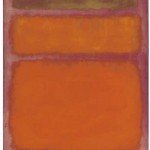Promoting Israel in the world of literature: A tale of Jewish ethnic networking
I was looking over Brenton Sanderson’s TOO article on Mark Rothko (“Mark Rothko, Abstract Expressionism, and the Decline of Western Art“). For Rothko, an artist without any of the skills that are traditionally associated with being a professional artist, it was all about Jewish networking.
Towards the end of 1943, all of the ethnic networking finally began to bear tangible fruit for Rothko. He befriended Peggy Guggenheim, “the most voracious patroness of American avant-garde art”, who had migrated to New York in 1941. Guggenheim’s artistic consultant, Howard Putzel, “convinced her to show Rothko in her Art of This Century gallery, where she had opened in 1942, during the low point of the war.” In January 1945, Guggenheim decided to put on Rothko’s first one-man exhibition at her gallery. In 1948 Rothko invited a coterie of mainly Jewish friends and acquaintances to view his new ‘multiforms’. The [very influential] art critic and historian Harold Rosenberg “remembers finding these works “fantastic,” and called his experience “the most impressive visit to an artist” in his life.”
This is actually quite remarkable. It would be one thing if Rothko was aspiring to be a leading rabbi or the head honcho at the ADL. But he was aspiring to fame and fortune as an historically important artist in the Western canon. He achieved his goal. One of his paintings recently sold for $87 million.
What reminded me of Rothko was a Mondoweiss article, “Pro-Israel literary subculture is poised to champion Shani Boianjiu, as it did Risa Miller.“) Here we find that the budding careers of two pro-Israel writers, Shani Boianjiu and Risa Miller, benefited massively from ethnic networking. The works of Boianjiu and Miller
portray Palestinians negatively. [Their work is] successful less on the literary merits than because they appeal to and have been supported by members of a Jewish-American subculture that is devoted to the promotion of the State of Israel.
Weiss describes Miller’s novel, Welcome to Heavenly Heights:
It is a paean to continuing Jewish dispossession of the Palestinian people, who lurk in the background of this tale as a faceless, senseless, violent, malevolent threat to the American settlers’ charming and heartwarming spiritual quest.
The book “received mostly rave reviews, with very few writers even mentioning the fact that the political realities of the Israeli occupation had been either ignored or had been distorted.”
Boianjiu’s short story recycles Israeli propaganda on the death of the a Palestinian family in the 2006 Gaza invasion, and it portrays Palestinians begging to be shot by Israeli soldiers in order to get media coverage.
The ethnic networking is obvious:
Like Miller, [Boianjiu] is being championed by a Jewish-American woman author who has already achieved considerable success. Miller received the patronage of Elinor Lipman, who if my memory is correct had taught Miller in a writing workshop. [Weiss comments on Lipman’s “oh-so-liberal image.” Since liberalism among Jews in the US is little more than a code word for anti-White attitudes, it illustrates once again the hypocrisy and double standards on ethnonationalism typical of the great majority of American Jews. Jewish ethnonationalism: good; White ethnonationalism: bad.] Boianjiu has been supported by the poet and novelist, Nicole Krauss. Both writers helped their proteges to win prestigious literary awards for novice authors. Miller won the PEN Discovery Award and Boianjiu the National Book Foundation 5 Under 35 prize (for which Krauss was her sponsor; and by the way, Krauss herself gained the attentionof Philip Roth and Joseph Brodsky).
Boianjiu’s story appeared in The New Yorker, a premier literary magazine. It was accompanied by an interview by fiction editor Willing Davidson. The editor-in-chief of The New Yorker is David Remnick, and the magazine is owned by Conde Nast Publications, a subsidiary of Advance Publications, which is a privately held company owned by Si Newhouse. The Columbia Journalism Review provides a long list of publications owned by Advance, including Vanity Fair and 36 other magazines or journals, 60 newspapers (mostly in small-town America), the Discovery cable TV channel, etc.
Jewish media ownership and control is a major arena for Jewish ethnic networking, especially noticeable at high-prestige, influential publications such as The New Yorker. Just as Rothko was successfully promoted to be part of the Western canon of high art, these writers are being promoted not as Israeli writers, but as part of the Western literary canon. Soon to be featured in college courses and made into movies.
Jewish ethnic networking is a critical source of Jewish power, ranging from the the worlds of art, literature and the media discussed here to the rise of the undistinguished Elena Kagan to Supreme Court justice (fueled by Larry Summers who rescued her from her status as an unemployed academic with a non-existent publication record to Dean of the Harvard Law School), to business networks, and the intellectual world. Where would Freud have been without his legion of Jewish backers within the psychoanalytic movement and in the media?
Jewish ethnic networking is the subtext not only of the sacrosanct position of Israel in the US media. It is also the subtext of the rise to dominance of the culture of critique and all that that entails in terms of multiculturalism and non-White immigration. We all accept a certain amount of ethnic networking as normal and natural—Jews are simply better at it than most. The problem comes when this ethnic networking creates an elite that is hostile to the traditional people and culture of the West or results in loyalty to Israel as the Jewish ethnostate at the expense of the best interests of the United States or other Western countries. Such an elite has no legitimacy, moral or otherwise.






Comments are closed.